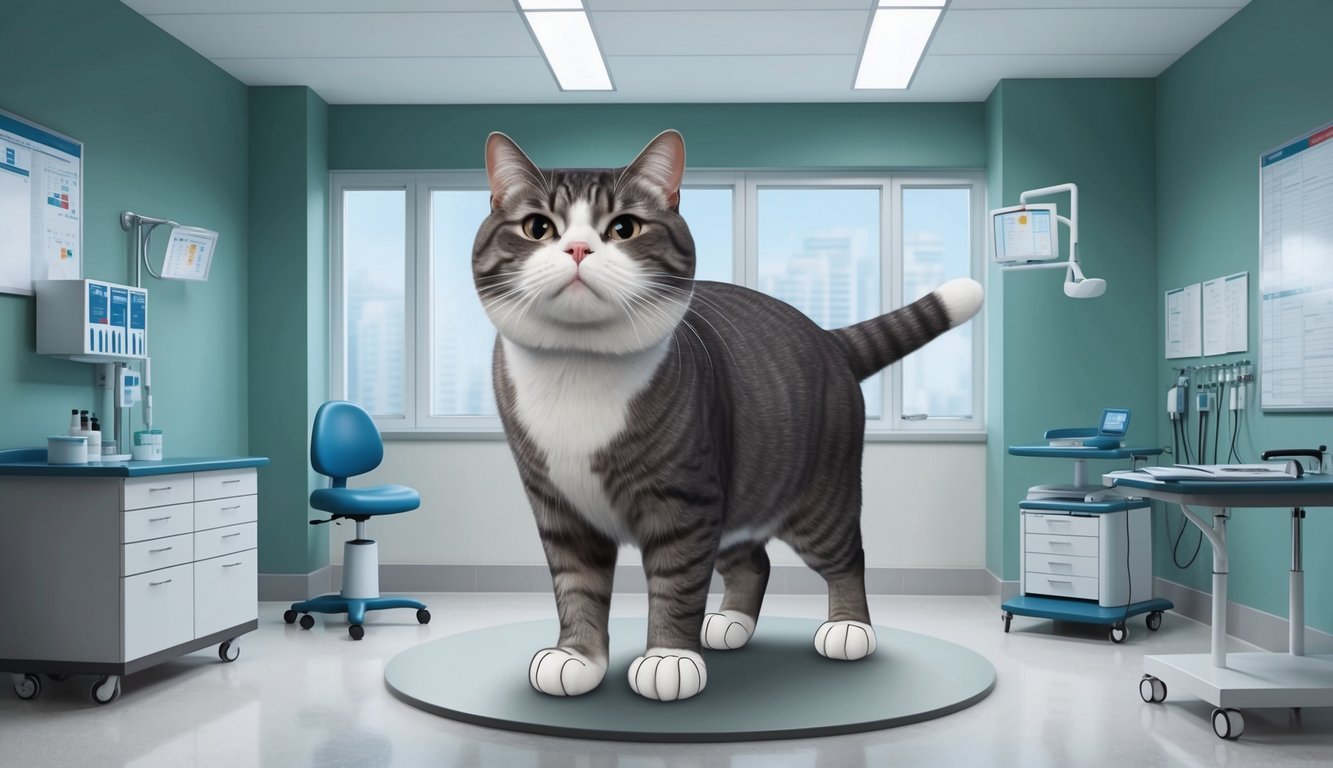Acromegaly in cats is a fascinating but serious condition that stems from excessive growth hormone secretion, often due to a pituitary tumor. Understanding this disease is crucial for cat owners, as its signs can be subtle and easily overlooked.
If your feline friend exhibits symptoms like enlarged paws, a swollen face, or does not respond to standard diabetes treatments, it might be time to consider acromegaly as a potential cause.
Diagnosing acromegaly can be challenging due to its gradual onset and the variety of symptoms.
You may notice physical changes, but accompanying laboratory tests and imaging can clarify the diagnosis.
Exploring treatment options is essential to manage the condition effectively, ensuring your cat’s quality of life remains a priority.
Knowing what to look for and understanding the implications of acromegaly can make a significant difference in your cat’s health journey.
By staying informed, you are better equipped to advocate for their needs and navigate the complexities of managing this rare yet impactful condition.
Key Takeaways
- Acromegaly is caused by excessive growth hormone secretion related to a pituitary tumor.
- Early diagnosis through physical examination and lab tests is vital for effective management.
- Treatment options exist to help improve the quality of life for affected cats.
Understanding Acromegaly
Acromegaly in cats is a condition primarily caused by the excessive secretion of growth hormone due to a pituitary adenoma.
This leads to a range of clinical signs and impacts overall health.
It’s crucial to recognize these aspects to provide proper care for affected cats.
Pathophysiology of Feline Acromegaly
In feline acromegaly, a pituitary tumor develops in the anterior pituitary gland, leading to the overproduction of growth hormone (GH).
This excess GH increases levels of insulin-like growth factor 1 (IGF-1), which contributes to various abnormalities.
As IGF-1 levels rise, your cat may experience organomegaly, or enlargement of organs, and weight gain.
The sustained high levels of GH cause not only physical changes but can also exacerbate other health issues like insulin resistance.
This situation often results in diabetes mellitus, where the body cannot properly use insulin.
Prevalence and Underdiagnosis
Acromegaly is often underdiagnosed, particularly in middle-aged and older male cats.
Studies indicate that this condition is more common in males; about 93% of diagnosed cases were male cats.
Many cats show symptoms similar to diabetes mellitus, which can distract from a proper diagnosis of acromegaly.
As a result, a high proportion of cases remain unrecognized, complicating treatment and management.
Clinical Signs and Symptoms
The signs of acromegaly can be subtle and vary widely among affected cats.
Common clinical signs include:
- Weight Gain: Your cat may gain weight despite having a good appetite.
- Polyuria: Increased urination can occur alongside diabetes.
- Polydipsia: Excessive thirst is common, as cats drink more to compensate for fluid loss.
- Polyphagia: An increased appetite may be present, complicating weight management.
Additional manifestations include distinct physical changes, such as enlarged paws or skull features.
Neurological signs can emerge if the tumor exerts pressure on surrounding tissues.
Keeping an eye on these symptoms can help ensure timely veterinary intervention.
Diagnosing Acromegaly in Cats
Identifying acromegaly in cats involves multiple diagnostic approaches to confirm the disease.
A combination of clinical evaluations, blood tests, and imaging techniques contribute to a confident diagnosis.
Common Diagnostic Tests
There isn’t a single test for diagnosing acromegaly in cats.
Typically, the process begins with a comprehensive physical examination and a detailed medical history.
Key tests include:
-
IGF-1 Measurement: This test evaluates insulin-like growth factor 1 levels, which are elevated in acromegaly. High IGF-1 levels can indicate excess growth hormone.
-
Diagnostic Imaging: Here, you have options like Computed Tomography (CT) and Magnetic Resonance Imaging (MRI) to visualize any abnormalities in the pituitary gland.
These tests help differentiate acromegaly from other conditions, particularly diabetes mellitus, which often coexists.
Blood Tests and Endocrine Testing
Blood tests play a crucial role in diagnosing acromegaly. Endocrine testing typically involves checking the cat’s blood for hyperglycemia and assessing insulin levels.
Elevated glucose and insulin resistance are common in affected cats.
- IGF-1 Levels: In addition to measuring IGF-1 directly, veterinarians may also look for patterns in blood glucose and hormone levels over time to confirm the diagnosis.
Abnormalities in complete blood counts, serum chemistry profiles, and urinalyses can provide further diagnostic clues.
Physical Exam and Additional Assessments
The physical exam is essential for identifying clinical signs.
You’ll want to watch for:
- Organomegaly: Enlarged organs can indicate underlying issues common in acromegaly.
- Growth Changes: Look for changes in extremities, such as enlargement of paws and skull.
Additionally, abdominal ultrasound might be conducted to assess organ structure.
These assessments, coupled with the results from blood tests and imaging, form a comprehensive picture for diagnosing acromegaly, ensuring that the right treatments can be pursued effectively.
Acromegaly-Related Health Complications

Acromegaly in cats leads to various health issues that affect the endocrine system and can create secondary complications.
It’s important to recognize these concerns to manage your cat’s health effectively.
Endocrine and Metabolic Issues
Acromegaly often causes insulin-resistant diabetes mellitus, which means your cat may struggle to regulate blood sugar levels.
This condition can manifest as increased thirst, frequent urination, and weight changes.
Unlike typical diabetic cats, those with acromegaly might not show weight loss; instead, they could remain overweight or have a normal body condition.
Additionally, acromegalic cats can experience hyperadrenocorticism, characterized by excess cortisol production.
This may lead to further complications, such as increased appetite, thinning skin, and a pot-bellied appearance.
Monitoring blood glucose levels is essential for diabetic control and can help gauge the severity of related metabolic issues.
Secondary Health Concerns
Aside from endocrine problems, acromegaly can lead to various secondary health concerns.
Hypertrophic cardiomyopathy is a common condition where the heart muscle thickens, affecting your cat’s heart function.
You may notice symptoms like lethargy or difficulty breathing.
Renomegaly and hepatomegaly may also occur, indicating an increase in kidney and liver sizes, respectively.
These changes can result in discomfort or dysfunction for your cat.
Lastly, there’s a risk of congestive heart failure, which could further compromise your cat’s health.
Regular check-ups are crucial to monitor these potential complications and adjust treatment as needed.
Treatment Options for Acromegaly
Managing acromegaly in cats involves various treatment options aimed at controlling the symptoms and addressing the underlying pituitary tumor.
You will find critical insights into medical management, surgical intervention, and radiotherapy.
Medical Management
Medical management can help control symptoms and regulate the cat’s insulin levels.
One common approach includes the use of somatostatin analogues like pasireotide.
This treatment reduces excess growth hormone secretion and can improve blood glucose levels.
Dopamine agonists, such as bromocriptine, are also utilized.
They work by inhibiting growth hormone release from the pituitary gland.
Monitoring your cat’s insulin dose is crucial, as medication may necessitate adjustments based on their response.
Regular veterinary check-ups will aid in determining the effectiveness of the treatment protocol and adjusting dosages as needed.
Keep in mind that while medical management can be effective, it often requires long-term commitment.
Surgical Intervention
Surgical intervention involves hypophysectomy, which is the surgical removal of the pituitary tumor.
This procedure can provide a more permanent solution by directly addressing the pituitary mass causing the acromegaly.
While effective, it is essential to discuss the risks and benefits with your veterinarian, as it may not be suitable for every cat.
Post-surgery, close monitoring is necessary to manage hormone levels and prevent complications.
Your veterinarian can guide you on what to expect during recovery and how to support your cat during healing.
If you’re considering this option, ensure that you have all the information about the procedure and potential outcomes.
Radiotherapy
Radiotherapy is another option that can be employed if surgery is not feasible or if the tumor recurs.
This approach aims at reducing the size of the pituitary tumor and controlling hormone overproduction.
While effective, it typically requires multiple treatment sessions and regular follow-up to assess its impact.
Side effects can occur, so maintaining communication with your veterinarian about any changes in your cat’s health is essential.
Radiotherapy can be a valuable part of a comprehensive treatment plan, especially for older cats or those with other health issues that complicate surgery.
Be prepared for a more extended treatment timeline and potential adjustments to your cat’s care as you navigate this pathway.
Living with Acromegaly

Managing a cat with acromegaly involves addressing both the hormonal imbalance and the related conditions like diabetes.
Proper treatment and care can improve your cat’s quality of life significantly.
Insulin Therapy for Diabetic Cats
If your cat develops diabetes due to acromegaly, insulin therapy will likely become a crucial part of their care.
Insulin injections help to regulate blood sugar levels and improve insulin sensitivity.
You may need to adjust the insulin dose based on your cat’s response to treatment.
Regular blood tests are essential to monitor glucose levels and determine if dose adjustments are necessary.
It’s important to keep a consistent schedule for insulin injections.
This helps stabilize your cat’s condition.
Some common signs that may indicate the need for a dose change include significant weight loss or unusual fluctuations in energy levels.
Monitoring and Follow-up Care
Regular monitoring is vital in managing acromegaly and its effects.
You should schedule veterinary visits at least every three to six months for blood tests to evaluate hormone levels and adjust treatment plans accordingly.
Watch for any clinical signs that could indicate complications, such as excessive thirst, increased urination, or changes in appetite.
These can signal issues with diabetes or other health concerns linked to acromegaly.
Maintaining open communication with your veterinarian will help you stay informed about your cat’s condition.
This partnership is crucial in ensuring the best possible outcomes for your feline friend.
Frequent check-ups enable early detection of any changes in health status, allowing timely interventions.
Prognosis and Survival

Understanding the prognosis and survival rates in cats with acromegaly can help you make informed decisions regarding their treatment and care.
Both short-term and long-term outlooks vary based on factors like the presence of underlying conditions and treatment options.
Short-Term Prognosis
In the initial phase after diagnosis, your cat’s short-term prognosis largely depends on the management of diabetes mellitus, which often accompanies acromegaly.
Treatment options may include insulin therapy to control blood glucose levels.
Recent studies indicate that around 16% of cats can experience hypoglycemia following surgery for pituitary tumors, which needs close monitoring.
Many cats stabilize briefly with proper management, but there’s still a risk of weight loss and other metabolic issues.
Ensuring a good quality of life involves frequent veterinary check-ups and monitoring behavioral changes.
Long-Term Prognosis
The long-term prognosis for cats with acromegaly who receive treatment varies.
The median survival time is reported to be about 1.5 to 3 years post-diagnosis.
Factors impacting this include the cat’s age, severity of symptoms, and response to treatment.
Long-term survival rates after interventions show 76% survival at one and two years, dropping to 52% by the third year.
Cats often face complications like organomegaly and may develop cardiomegaly over time.
Quality of life is crucial; ongoing veterinary care can enhance your cat’s comfort and well-being as they navigate this chronic condition.
Frequent check-ups can help detect changes early, allowing for timely adjustments in treatment.
Recent Advances and Research
Recent studies have improved our understanding of acromegaly in cats.
One key area of focus is feline growth hormone (GH), which is often produced in excess due to a benign pituitary tumor.
This condition is primarily diagnosed by measuring IGF-1 concentrations.
Elevated levels—typically greater than 1000 ng/mL—indicate the presence of acromegaly.
This lab test is a reliable diagnostic tool, offering a 95% positive predictive value.
Research has highlighted that acromegaly may be more common in diabetic cats than previously thought.
This has led to increased screening efforts and earlier detection.
Another advancement involves treatment options.
Recent findings suggest that radiation therapy can be effective for managing pituitary tumors associated with acromegaly.
In studies involving 56 cats, a significant percentage saw improvement with this method.
Additionally, a review by the Pituitary Society addressed individualized treatment strategies.
Tailoring therapy to each cat’s specific needs is becoming a standard practice.
Clinical studies continue to emerge, shedding light on the natural history of the disease.
Keeping up with the latest research can help you provide the best care for your feline friend.
Frequently Asked Questions
Acromegaly in cats can raise many questions for pet owners.
Understanding the signs, treatment options, and implications of this condition can significantly help you in providing the best care for your feline friend.
What signs indicate a cat might have acromegaly?
You may notice several physical changes in your cat.
Common signs include enlarged paws and facial features, like a broader jaw.
Increased thirst and urination are also typical, along with symptoms of diabetes mellitus.
How is acromegaly typically treated in felines?
Treatment often involves managing symptoms rather than curing the disease.
Options include medication to reduce growth hormone levels and radiation therapy to shrink the tumor.
Surgical removal of the tumor is another possible approach but comes with its risks.
Can acromegaly cause pain for affected cats?
While acromegaly itself may not directly cause pain, related symptoms can lead to discomfort.
The growth of internal organs or bones could contribute to a cat’s overall distress.
Regular veterinary check-ups can help monitor any pain your cat may experience.
What is the average lifespan of a cat diagnosed with acromegaly?
The lifespan of a cat with acromegaly can vary significantly.
With appropriate management, many cats can live for several years post-diagnosis.
Factors such as the overall health of your cat and how well the condition is managed play crucial roles in longevity.
What are the common causes behind acromegaly in cats?
The primary cause of acromegaly in cats is a growth hormone-secreting tumor in the pituitary gland.
These tumors generally develop slowly over time and can lead to chronic excessive hormone production.
Stress or obesity may also contribute to the disease’s onset.
How is acromegaly diagnosed in cats?
Veterinarians diagnose acromegaly through a combination of physical examinations and blood tests.
They measure levels of insulin-like growth factor 1 (IGF-1) to confirm the condition.
Imaging tests, such as ultrasound or MRI, may also be recommended to assess the tumor’s presence.

